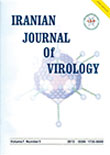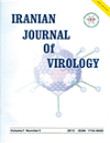فهرست مطالب

Iranian Journal of Virology
Volume:11 Issue: 2, 2017
- تاریخ انتشار: 1396/03/13
- تعداد عناوین: 6
-
-
Pages 1-7Background And AimsNewcastle disease (ND), caused by the virulent Newcastle disease virus (NDV), is one of the most important viral diseases in birds. In recent years recombination occurring throughout the NDVs genome isolated in China and Indonesia has been reported. This study was focused to investigate the recombination events in the F gene of the Iranian NDVs to generate useful data that can be applied in controlling programs.Materials And MethodsSequences of 1200 base pairs of the F gene of Iranian NDVs were analyzed compared with the isolates from other reference strains. Divergence between the gene sequences and the influence of natural selection were estimated. The neutralizing epitopes and potential N-glycosylation sites within F proteins were determined. Possible recombination within the sequences was analyzed using RDP3 software.ResultsAlignment and phylogenetic analysis based on the F gene revealed that Iranian NDVs share a higher nucleotide identity with NDVs representing genotype VII and further clustered into two sub-genotypes. The calculated Ka/Ks and negative Tajimas D test indicate purifying/stabilizing selection. No recombination events were detected in F gene of Iranian NDV sequences deposited in GenBank.ConclusionsWhile no recombination event was identified for the gene, constant molecular and pathological characterization of circulating NDVs are needed to detect an evolutionary feature of the viruses.Keywords: Newcastle disease virus, fusion protein gene, recombination, evolution
-
Pages 8-13Background And AimsBorna disease virus (BDV) is well known as a neurotropic virus, however, its role in human neurological diseases such as schizophrenia and bipolar disorder is still unclear. In this study, we aimed to investigate the BDV genome in such patients in Golestan province, North of Iran.Materials And MethodsRNA was extracted from peripheral blood mononuclear cells (PBMCs) from 250 people (125 patients with bipolar disorder (94.5%) and schizophrenia (3.1%) and 125 sex and age-matched healthy blood donors). Demographic information was collected through a questionnaire. RNA-driven cDNA was used for further BDV P40 genome tracking by Polymerase Chain Reaction (PCR).ResultsOnly one sample (1/125; 0.8%) of a female patient with bipolar disorder found to be positive for BDV P40. No significant family history of the disease found in both groups of patients. Seven patients with bipolar depression disorder (5.5%) had a history of animal contact.ConclusionsNo BDV genome has been detected in the blood samples of the patients admitted to the hospital section of psychiatry in Gorgan city. Despite other genetic and environmental factors involved in psychiatric disorders, the serological study will give us a better insight of BDV prevalence in the region.Keywords: Borna disease virus, P40, Reverse Transcriptase Polymerase Chain Reaction, schizophrenia, bipolar depressive disorder
-
Pages 14-18Background And AimsWorld Health Organization Global Polio Laboratory Network (GPLN) plays a critical role in the Global Polio Eradication Initiative. Cell culture methods (mostly RD and L20B cell lines) have been used for Enteroviruses and polioviruses isolation, respectively. Cross-contamination among L20B and RD cell lines causes the problem in accuracy of poliovirus surveillance and decreases the poliovirus detection. Therefore, validation of identity of cell lines purity is a vital part of cell culture in polio laboratory.Materials And MethodsIn this study, a multiplex SYBR-Green PCR based on Cytochrome b oxidase amplification was designed to L20B and RD cell lines cross-contamination.ResultsThe conventional multiplex PCR performed on DNA extracted from L20B cells deliberately cross-contaminated with RD cells clearly showed not only the identity of L20B cell line but also the presence of contaminant RD cells.ConclusionsThe results indicated that the multiplex SYBR-Green PCR was reliable method to identity L20B and RD cell lines individually and also after deliberate cross-contamination.Keywords: Multiplex SYBR, Green PCR Poliovirus, Cell line authentication
-
Pages 19-28Background And AimsAvian infectious bronchitis virus (IBV) has a worldwide distribution and mutations occurring in the large viral genome of IBV have led to extensive antigenic variations among IBVs. This is the first study conducted to determine the complete membrane (M) gene sequences of different Iranian IBV genotypes.Materials And MethodsThe M gene of three 793/B (IBKG1,6,7), one Massachusetts (IBKG3), three Variant 2 (IBKG2,4,9), four QX(IBKG5,10,11,12) and one IR-1(IBKG8) Iranian IBV isolates were sequenced and analyzed. Also, post-translational modifications of the M glycoprotein were predicted.ResultsSequence analysis of the M gene indicated IBKG1, 6, 7, and 8 shared the highest homology to 793/B genotype. IBKG2, 4, 5, 9, 10, 11, and 12 showed the highest similarity to QX-like IBV. IBKG3 (Massachusetts) isolate shared 99/53% identities with H120 vaccine strain, respectively. Although M proteins are moderately well conserved within each coronavirus genus, the sequence differences of M gene reached to 12% among Iranian IBV isolates. Based on M gene analysis, IBKG-8 (IR-1 genotype) and all Variant2 IBVs, classified as a 793/B and QX IBV according to the M gene sequences, respectively.ConclusionsIt is the first characterization of IR-1 (Iranian local genotype) based on M gene. Also, the data shows M gene of variant 2 IBV strains are derived from QX genotypes. The results complete the Iranian IBVs genetic puzzle.Keywords: M gene, Avian Infectious Bronchitis, Sequencing, Phylogenetic, Iran
-
Pages 29-35Background And AimsHepatitis C virus (HCV) is a member of the Flaviviridae family, which causes approximately 500,000 deaths annually. HCV infection treatment is often associated with significant adverse effects. Curcumin is an active ingredient of turmeric which has therapeutic anti-inflammatory effects in many diseases including infectious ones. Although curcumin is not soluble in water, if it is synthesized in the form of nanomicelles, it will be water soluble and can be absorbed in the gastrointestinal tract (GI). In this study, the antiviral effects of curcumin nanomicelles were investigated on the attachment and entry of HCV particles.Materials And MethodsThe cytotoxicity of curcumin nanomicelles was determined in Huh7.5 cells and their antiviral effects on the attachment and entry of HCV was investigated in a cell culture system.ResultsCurcumin nanomicelles could decrease the viral load in the cell culture supernatants compared to virus control.ConclusionsAccording to the results of this research, we determined the antiviral effects of curcumin nanomicelles in the later stages of HCV replication.Keywords: Hepatitis C virus_Curcumin_Herbal medicines_Nanomicelles
-
Pages 36-42Background And AimsInfluenza is an acute respiratory illness that is caused by a virus belonging to Orthomyxoviridae family. This virus spreads rapidly every year in cold season and leads to morbidities and mortalities especially in adults and children, which causes billions of dollars of economic losses. Accordingly, development of a rapid, sensitive and inexpensive laboratory diagnosis based on antigen detection to distinguish this infection from other respiratory tract viruses is important. In addition, specific anti-influenza antibody production against influenza virus antigen is essential for basic and applied research programs. Influenza A virus nucleoprotein (NP) is a structural protein and a major component of the ribonucleoprotein complex. It has a high expression level during infection. NP consists of 498 amino acids with molecular weight of 57 KD. The aim of this study was to produce and purify polyclonal antibody against recombinant nucleoprotein of the influenza A virus.Materials And MethodsRabbit immunization was performed based on a specific program by NP purified recombinant antigen and Freund's adjuvant. Serum immunoglobulin was separated by ammonium sulfate and IgG purification was conducted by ion exchange chromatography (DEAE-cellulose). To evaluate the reaction between antigens and purified antibodies, SRID and ELISA serological tests were applied.ResultsThe results obtained from SDS-PAGE and Western blot showed a dense band of purified NP. The results of ELISA confirmed an increase in NP antibody titer after one month. Antibody levels detection by ELISA showed a sensitivity of 1 to 50. In SRID, sedimentary areola was observed due to the interaction of NP antigen and antiserum. Western blot results were also positive for the NP protein.ConclusionsThe NP antigen purified in this study, as well as the produced and purified antibodies, had the ability to be used in serological tests to detect influenza A virus. It can also be used in basic research methods such as Western blot, immunohistochemistry and immunocytochemistry.Keywords: antigen purification, polyclonal antibody production, antibody purification, Western blot


